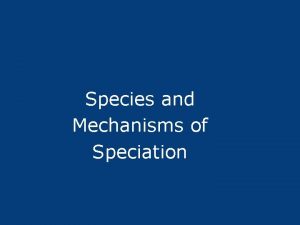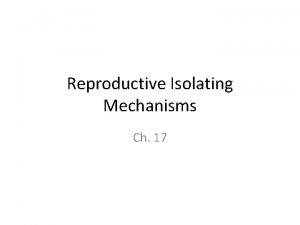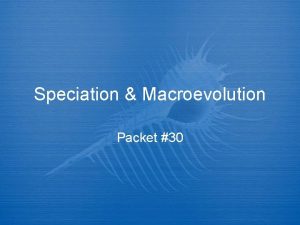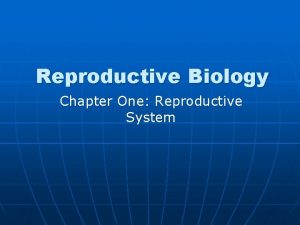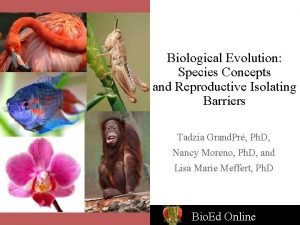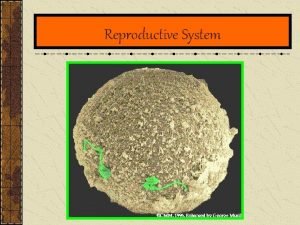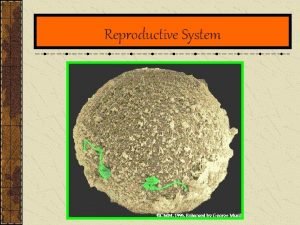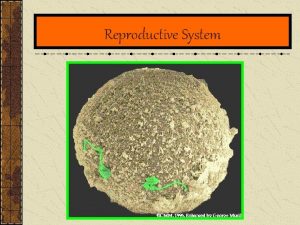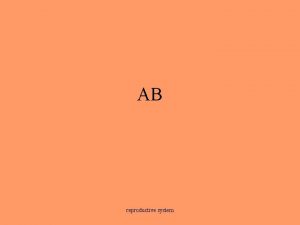I REPRODUCTIVE ISOLATING MECHANISMS in order for one


















- Slides: 18

I. REPRODUCTIVE ISOLATING MECHANISMS in order for one population to become very different from another, they must be reproductively isolated, this means that there will no longer be a free exchange of alleles between the two populations there are Prezygotic mechanisms that prevent mating or fertilization and Postzygotic mechanisms that prevent development of a zygote

1. PREZYGOTIC MECHANISMS a. Ecological Isolation two populations do not exchange alleles with each other because they are in different geographic places or at different places within the same ecosystem

eg. cheetah and tiger do not meet because one is in Africa and one in Asia cheetah range tiger range

eg. Asiatic lion and Bengal tiger are both in northern India, but lion is on savannah and tiger in forest

b. Temporal Isolation two populations do not exchange alleles because they are only available to exchange alleles at different times of year or even of the day eg. morning glory opens its flower at sunrise; cactus opens its flowers at sunset

eg. purple finch mates in June so babies have access to lots of berry seeds goldfinch mate in August so that babies have access to lots of thistle seeds

c. Behavioural isolation two populations do not exchange alleles because they do not respond to each others mating rituals eg. male grey crickets rub legs at 25 times a second male black crickets at 45 times a second the females of each species only responds to the sound made by the male of that same species

d. Mechanical Isolation two populations do not exchange alleles because of some physical barrier that prevents this eg. many insects have modifications on their exoskeletons such that the male and female parts are a perfect 'lock-and-key' fit

eg. orchids are shaped so that only certain beetles can reach the nectar and therefore pick up the pollen, that beetle will the go to another orchid of the same type to deposit the pollen

e. Gametic isolation two populations exchange sperm and eggs but chemical markers prevent the eggs from being fertilized by the 'wrong' sperm and so no alleles are exchanged eg. wind blows the pollen of corn onto the flowers of milkweed, but the pollen can not grow down through the stigma because it does not possess the correct enzyme

eg. clams and fish both shed eggs and sperm into the same water, but the clam sperm can not penetrate the fish eggs and vice versa, due to enzymes not being able to eat through zona pellucida

REPRODUCTIVE ISOLATING MECHANISMS # 11 -17 work on these HW show is not over!!

2. POST-ZYGOTIC ISOLATING MECHANISMS a. Zygotic mortality - even though the zygote is created, it fails to develop to maturity

b. Hybrid inviability- even though the hybrid is born, it does not live long or is not as healthy

c. Hybrid infertility - even though the hybrid is healthy and vigourous, it is not able to reproduce eg. donkey X horse mule eg. lion X tiger liger healthy and strong but mules are sterile healthy & strong; but ligers are sterile

3. SPECIATION when two populations become completely isolated and no longer exchange alleles, they are said to have formed separate species

a. Allopatric speciation - this is a situation in which the two populations are geographically isolated prior to them becoming separate species the population is isolated and then the changes occur due to new environments

b. Sympatric speciation - this is a situation where the two populations remain in physical contact with each other but still stop exchanging alleles and become separate species although not separated, the population undergoes different selection pressures and changes occur over time in allele frequencies
 Allopatric
Allopatric 1st order 2nd order 3rd order neurons
1st order 2nd order 3rd order neurons One god one empire one religion
One god one empire one religion One one little dog run
One one little dog run One king one law one faith
One king one law one faith One god one empire one emperor
One god one empire one emperor One ford behaviors
One ford behaviors See one do one teach one
See one do one teach one See one, do one, teach one
See one, do one, teach one One face one voice one habit and two persons
One face one voice one habit and two persons See one do one teach one
See one do one teach one Asean tourism strategic plan
Asean tourism strategic plan Asean one vision one identity one community
Asean one vision one identity one community Kontinuitetshantering i praktiken
Kontinuitetshantering i praktiken Typiska drag för en novell
Typiska drag för en novell Tack för att ni lyssnade bild
Tack för att ni lyssnade bild Returpilarna
Returpilarna Varför kallas perioden 1918-1939 för mellankrigstiden
Varför kallas perioden 1918-1939 för mellankrigstiden En lathund för arbete med kontinuitetshantering
En lathund för arbete med kontinuitetshantering
